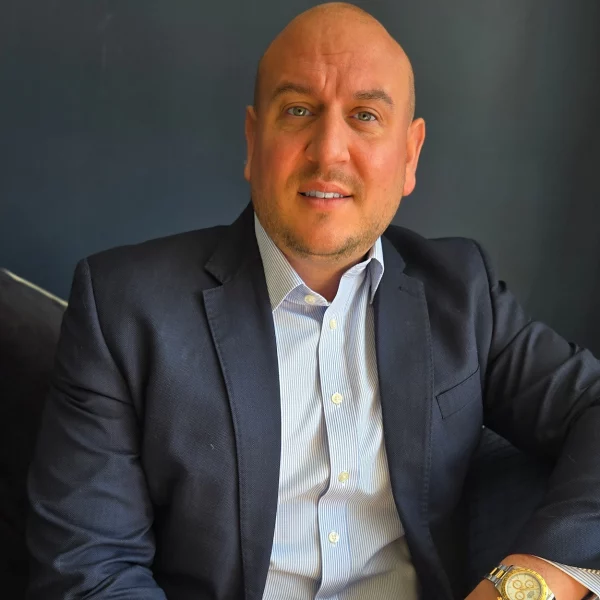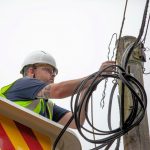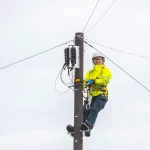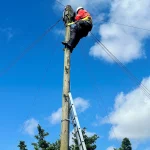Rob Bradley on Consolidation and Fixing the Turbulent UK Fibre Broadband Market

The Managing Partner of M&A-focused consultancy firm the Bradley Strategy Group, Rob Bradley, has today spoken to ISPreview as part of a new interview that lifts the lid on the “strategic recalibration” that is currently occurring across the UK’s alternative fibre networks – driving a wave on consolidation to correct for today’s “structurally misaligned market“.
According to figures released by the Independent Networks Co-operative Association (INCA), alternative broadband networks (excluding Openreach, Virgin Media and KCOM) are currently delivering full fibre (FTTP/B) lines to 16.4 million UK premises or 15.2m when overbuild between altnets is removed (here). Some of the biggest players in this space include CityFibre (c.4.5m premises), Netomnia (2.5m), nexfibre (2.2m), Hyperoptic (1.9m) and CommunityFibre (1.5m), but there are many more (Summary of UK Full Fibre Builds).
However, as our regular readers will already know, most altnets are currently looking at consolidation as a way of balancing against the increasingly difficult market conditions that have arisen over the past 2-3 years. Much of the latter has been driven by high interest rates, rising build costs and strong competition – all of which is making it hard to raise fresh investment.
Advertisement
In the past our interviews on this subject have tended to focus on talking to the network operators and retail ISPs themselves. So this time we thought it might be interesting to get the perspective of the Bradley Strategy Group, a boutique strategy consultancy focused on the UK fibre sector, particularly the consolidation of altnets.
The company has previously worked with firms like Fern Trading, Speed Fibre, and CityFibre, and they’re currently advising on multiple real-world mergers and integration plans within the altnet landscape. According to Rob Bradley, Managing Partner of BSG, the current “structurally misaligned” market suffers from having “too many operators, with overlapping footprints and duplicated costs, serving too few customers.” Not to mention that consumers haven’t always had a “compelling reason to switch” or were unaware of the new network choice(s).
“The issue is that the second part of the equation, “build it and they will come”, hasn’t materialised at the speed investors hoped. Take-up is lower than forecast. Operating costs remain high. And with limited revenue flowing in, many operators are now falling short of their own commercial projections, not because they failed to build, but because the expected returns haven’t followed,” said Rob.
In response, many altnets have had to slow or stop their network builds in order to focus on greater commercialisation, which tends to be followed by redundancies. But this has left a market with a lot of smaller players and an inevitable expectation toward more mergers and acquisitions. “For the best-positioned players, this is the time to scale with purpose,” said Rob. “Consolidation is not a last resort, but a strategic enabler, particularly when it leads to stronger commercial focus, platform efficiency, and capital access.”
Advertisement
On the other hand, many deals are still being “stalled by valuation gaps,” with some sellers often holding onto unrealistic valuations, often at the same time as “buyers are pricing based on actual take-up, cost to serve, and integration overhead“. The full interview delves into all of this and covers what altnets get right, what they get wrong and the changes that are needed to deliver a positive outcome.
This is particularly relevant as the next 12–24 months may well materially reshape the market.
The Bradley Strategy Group Interview
1. As a strategy consultancy focused on the UK fibre sector, you’ve worked with various investors and network operators and are currently advising on multiple real-world mergers and integration plans within the AltNet landscape.
Suffice to say that you no doubt have quite a strong insight into the current trend toward greater market consolidation between operators. So far this has got off to a bit of a slow-ish start (i.e. a good chunk of early consolidation has been more internal, between companies owned by a single shared investor). But I understand you’re expecting consolidation to pickup over the next 12-24 months.
Advertisement
Is the expected acceleration primarily because the wider economic strains are catching up with operators that have been trying to hold it back and, past a certain point, they may have little choice but to consolidate?
Rob Bradley said:
Yes, survival is now a central force, but the full picture is more than just financial distress. What we’re seeing is a strategic recalibration across the UK fibre landscape.
The capital that underpinned the initial wave of AltNet activity has largely been deployed. Most operators were backed with a clear mandate: build as fast as possible, hit premises targets, and trust that commercial traction would follow. So they built. But today, many of those plans have either completed, been exhausted, or are now facing refinancing risk, as debt providers reassess their exposure to the sector in a very different economic climate.
The issue is that the second part of the equation, “build it and they will come”, hasn’t materialised at the speed investors hoped. Take-up is lower than forecast. Operating costs remain high. And with limited revenue flowing in, many operators are now falling short of their own commercial projections, not because they failed to build, but because the expected returns haven’t followed.
We now face a structurally misaligned market: too many operators, with overlapping footprints and duplicated costs, serving too few customers. Mathematically and operationally, the sector needs fewer players covering larger areas. That’s the only way to drive unit cost efficiencies and deliver sustainable commercial returns.
So why didn’t the “gold rush” happen?
Because consumers haven’t had a compelling reason to switch. Many households still receive 40–60 Mbps over FTTC, speeds that remain sufficient for typical usage. And those broadband lines are often bundled with mobile, TV, or content services that increase stickiness. Switching to full fibre, especially via an AltNet, can feel disruptive: drilling walls, digging drives, changing contracts, and potentially losing bundle benefits. In the absence of a pressing use case or financial incentive, inertia wins.
Crucially, we never removed the legacy alternative. In Singapore, copper was retired as fibre rolled out, creating system-driven urgency. In New Zealand, a regulated copper withdrawal code is supporting fibre migration, region by region. In the UK, however, fibre and copper continue to coexist, and Openreach’s PSTN switch-off doesn’t eliminate copper broadband. Without regulatory push or consumer pull, there’s no tension driving the switch, and adoption lags.
This has exposed a key weakness in many early AltNet business plans: optimistic assumptions around exclusivity of footprint, rapid take-up, switching behaviour, and long-term infrastructure value. Those assumptions haven’t held, and investor focus is now shifting: from coverage to conversion, from homes passed to homes connected.
Capital hasn’t disappeared, it’s just chasing different outcomes. Monetisation, cost-to-serve, and platform resilience now matter more than build metrics. Investors are asking tougher questions about ARPU, customer lifetime value, and the operational gearing of each platform.
As a result, we’re seeing the maturation of investor logic. Early consolidation moves, often within single portfolios, were about stabilising positions. But the next wave of transactions will require real strategic intent: platform integration, footprint rationalisation, systems alignment, and brand consolidation.
And those deals are much harder. They demand not just capital, but capability: deep integration planning, shared technology architecture, operating model transformation, and culture alignment. This is no longer a volume game, it’s a capability race.
So yes, financial pressure is accelerating consolidation. But what we’re really witnessing is a correction to the business model. A moment of reckoning, yes, but also one of opportunity. For the best-positioned players, this is the time to scale with purpose.
2. What aspects of consolidation do you see as working in the current market and what’s not?
Rob Bradley said:
The most encouraging development is the shift in mindset. There’s growing recognition that consolidation is not a last resort, but a strategic enabler, particularly when it leads to stronger commercial focus, platform efficiency, and capital access. We’re seeing operators and investors move beyond the early fixation on premises passed, and start to prioritise connections, take-up, and operating leverage, the fundamentals that actually drive value.
Structurally, we’re seeing some smart dealmaking emerge. The CityFibre–Lit Fibre deal is a good example: it was built around technical alignment, a clean equity structure, and a clear integration thesis. The FullFibre–Zzoomm merger showed how combining mid-sized footprints can push a business past key scale thresholds, creating the kind of operational and financial profile that attracts further investment.
What’s also working is the recognition that aligned systems and architectures make a material difference. When platforms are compatible, whether CRM, OSS, or provisioning, integration timelines shorten, complexity reduces, and value is unlocked faster. Consolidation is no longer just about acquiring fibre in the ground; it’s about acquiring capability.
On the other hand, many deals are still being stalled by valuation gaps. Sellers often hold onto pre-2022 expectations, while buyers are pricing based on actual take-up, cost to serve, and integration overhead. Without creative structures, like equity rollovers or staged consideration, that gap is difficult to close.
And even when deals are agreed, integration remains the single most underestimated challenge. Differences in systems, data models, provisioning logic, and even support processes can introduce real operational risk if not planned for early. The best consolidation strategies are now building integration plans before the deal closes, not after.
In short, what’s working is commercial discipline, architectural alignment, and creative structuring. What’s not is late-stage integration planning and valuation rigidity. The more consolidation is approached with clear execution intent, not just financial ambition, the more successful it becomes.
3. What do you see as the key barriers for consolidation, which are still in play today?
Rob Bradley said:
While the strategic logic for consolidation is now widely accepted, scale efficiencies, rationalised footprints, shared systems, the barriers to action remain stubbornly real.
Capital structure misalignment
Many AltNets are still backed by investors with different timelines, return profiles, and governance structures. Some are open to equity-based combinations; others are debt-laden and focused on refinancing. This divergence creates friction: deals that make strategic sense often fail on financial alignment.
Valuation expectation gaps
Founders and investors are often anchored to valuations set during the peak of the market, typically based on homes passed or funded build, not on revenue or take-up. Buyers, meanwhile, are now pricing deals on penetration, EBITDA, and commercial traction. The gap between these views of value can delay or derail deal-making, especially for underperforming networks.
Pre-consolidation posturing
There is a growing awareness across the sector that consolidation is inevitable, but without widespread cash deals, many fear being subsumed on terms that understate their potential. This leads to strategic positioning: some operators may delay engagement, pursue additional growth, or extend their footprint to enhance value ahead of potential talks. While understandable, this can unintentionally slow down the consolidation.
Transactional and governance complexity
What often looks like a straightforward commercial merger on the surface hides a deep layer of structural complexity. Many AltNets are owned via SPVs or holdco arrangements, with minority investors, convertible debt, or waterfall structures that require bespoke legal negotiation. Deals may need shareholder approvals, creditor consents, or the restructuring of security positions. Add to this the need for tax-efficient merger structures, TUPE considerations, and a detailed review of legacy contracts and liabilities, and even aligned parties can take months to execute a transaction. The friction here is not just commercial, it lies in the layered legal, financial, and governance complexities that underpin most transactions.
Integration risk and system complexity
Even when two operators want to merge, the practical complexity of integration can kill momentum. Misaligned OSS/BSS platforms, incompatible provisioning and support models, fragmented customer records, TUPE obligations, and billing architecture mismatches all represent execution risk. Without a clear and costed integration plan, many acquirers walk away.
Lack of neutral, shared platforms
Unlike sectors such as mobile or energy, the UK fibre market lacks a standardised wholesale access framework or common technology backbone. Each network has grown independently, using different architectures and commercial terms. As a result, every merger becomes a custom integration challenge, raising cost, risk, and time.
Unclear regulatory incentives
There is no national mandate or regulatory encouragement to consolidate, no copper switch-off deadline driving urgency, and limited policy intervention to reduce inefficient overbuild. In markets like New Zealand or Singapore, consolidation was structurally enabled. In the UK, it remains voluntary, fragmented, and investor driven.
The biggest challenge isn’t strategic, it’s executional. The sector has a consolidation thesis that makes sense on paper, but getting deals over the line requires navigating valuation tension, legal architecture and operational friction. Without that full-stack view, consolidation risks remaining more aspiration than action.
4. What things do you look to see in a network operator that might, in this climate of rising consolidation, distinguish likely winners from those most at risk?
Rob Bradley said:
I look for six things that distinguish likely winners in today’s climate of consolidation:
Strong unit economics and low debt exposure.
Operators with a healthy debt-to-revenue ratio and prudent capital deployment stand out. High leverage in a high-interest environment limits flexibility and raises exit risk.A leadership team with proven operational and commercial delivery.
Having execs who’ve scaled networks before, whether in fibre, cable, or mobile, brings credibility and hard-earned operational discipline. Experience matters when moving from 10K to 100K customers.A scalable and efficient technology platform.
The ability to add customers without linearly adding headcount or systems complexity is a critical differentiator. We’re particularly interested in whether the operator has clean APIs, modern CRM and billing platforms, and solid provisioning/orchestration, not technical debt and manual workarounds.Thoughtful build strategy with minimal overbuild exposure.
Operators who’ve avoided the most heavily contested urban markets or who have secured demand-side commitments (e.g. council partnerships, anchor tenants) are structurally advantaged. Gross margin is harder to sustain when you’re the third fibre line into a street.Commercial traction, take-up on RFS.
Build is no longer enough. Investors are watching take-up closely. A growing penetration rate is a strong indicator that the go-to-market strategy is working and that the business has real potential for EBITDA breakeven.Experience at Network, systems & organisational integration
As the market consolidates, those who can integrate efficiently across networks, systems, and people, will be best placed to realise the value of their deals. Integration isn’t just a back-office exercise; it’s where synergies are won or lost. Operators with experience aligning architecture, migrating customers, and unifying operating models will move faster, reduce cost, and instil greater investor confidence. In a sector where consolidation is inevitable, integration capability is fast becoming a defining competitive advantage.There is one notable outlier in the market, and that’s CityFibre. Unlike most AltNets, CityFibre has pursued a deliberate scale-first strategy, fuelled primarily through debt. While this approach will inevitably face increasing pressure as capital becomes more expensive, it’s important to acknowledge what the team has achieved: they have built a scaled infrastructure challenger to Openreach in the UK.
No operator is immune to market risk, but CityFibre now appears well-positioned to emerge as one of the long-term winners and a likely centre of gravity in the eventual consolidation of the sector. Their strategic partnerships, including Vodafone, AllPoints Fibre, and, more recently, Sky, provide strong wholesale channels, and their national footprint gives them operational relevance at scale.
The coming years will be critical. The model depends on continued take-up, successful integration of acquired assets, and sustained access to refinancing. But based on current trajectory, CityFibre looks set to play a defining role in the UK’s fibre future.
Please flick over to Page 2 in order to finish reading the interview.
Mark is a professional technology writer, IT consultant and computer engineer from Dorset (England), he also founded ISPreview in 1999 and enjoys analysing the latest telecoms and broadband developments. Find me on X (Twitter), Mastodon, Facebook, BlueSky, Threads.net and Linkedin.
Advertisement
Leave a Reply Cancel reply
Privacy Notice: Please note that news comments are anonymous, which means that we do NOT require you to enter any real personal details to post a message and display names can be almost anything you like (provided they do not contain offensive language or impersonate a real person�s legal name). By clicking to submit a post you agree to storing your entries for comment content, display name, IP and email in our database, for as long as the post remains live.
Only the submitted name and comment will be displayed in public, while the rest will be kept private (we will never share this outside of ISPreview, regardless of whether the data is real or fake). This comment system uses submitted IP, email and website address data to spot abuse and spammers. All data is transferred via an encrypted (https secure) session.























































“But connections, not coverage, drive revenue, and the optimal model would have been “connect as you build”, ensuring demand generation, operational readiness, and monetisation occurred in tandem with rollout. In hindsight, a national BDUK-style model, with defined build zones and a competitive bidding process, may have created a more capital-efficient and sustainable national fibre footprint, not just in hard-to-reach areas, but across the whole country.”
Some of us have been making these very points in the comments section of this website for the last couple of years.
Monopolies (either geographical or over a particular resource) especially accompanied with a competitve bidding process are rarely (never?) good for consumers. On top of the ongoing issues of managing monopolies, investors not only need to build out the infrastructure, as now, but also pay for the right to the monopoly driving up costs. It’s true the overall amount of capital invested would be lower as there would be little cost to competitors of failure, but I really don’t think we should care about that – better luck next time to those investors.
Build and then they will come . This shows the ridiculous overbuild for what it is .A travesty allowed by government legislation permitted development for telecommunications installations and poor operator practise with little regard to any sound business practise and no regard to customers home environments and communities. Duplicate, triplicate telegraph poles . Telegraph poles where all infrastructure was underground and huge masts . Telecommunications code of practise that is unfit to ensure best practise and allows the ruin of our streets
“too many operators, with overlapping footprints and duplicated costs, serving too few customers.”
Exactly. Had the previous government imposed no overbuild until the majority of the country covered, perhaps DankshireTown would have had total coverage, instead of the situation of supplier (cannot name for legal reasons) who pulled out of BDUK. and the other supplier (cannot name for legal reasons) not completing the job.
Now our hopes on OR.
Even the FTTC rollout was a farce, controlled by Dankshire Council, who failed to understand the technology, resulting in many folks outside the 1km limit (as quoted in the Huawei installer manual. I wont mention we could have had fibre over 15 years ago unless I upset someone.
How is CDS?
@The Facts says:
How is CDS?
What is CDS
Likely still wouldn’t have anything. Without overbuild no race for premises passed so fewer networks around each focusing on profitability rather than growth. Take away the ability to pursue a ‘build it and they will come’ approach you also take away access to funding for it.
Wherever Dankshire Town is with all the dependence on government subsidy it’s presumably not considered an area likely to be profitable any time soon even with a monopoly.
On the wider point requiring no overbuild means telling Openreach that others may use their ducts and poles to build and Openreach then can’t use their own passive infrastructure to overbuild. That is unlikely to stand up to legal challenges without a huge amount of changes to various laws and leaves options of forcing network builders to build their own network with no use of PIA, pricing most of them out, or nationalising the most expensive bits of BT. For at best minimal coverage increase.
Dankshire town has a population > 10000, and properties > 4000, and is quite prosperous. It enjoys sub-standard broadband in many locations.
Infrastructure exists , combination of poles and ducts.
The point is that if the rollout had been sublect to no overbuild, then the town would have service quicker.
I know of another town where despite having greater population & properties, OR have now restarted building in the remaining half, where an altnet has already installed its infrastructure.
The government of the time clearly did not think broadband deployment out.
I don’t think banning overbuild would have achieved a better outcome. The cable TV networks were built in this way as companies held an exclusive regional franchise. We ended up getting heavily restricted coverage with entire counties left out, financial difficulties and mass consolidation, and that’s despite rigging it so that BT can’t adequately compete.
In the pre-broadband, pre digital TV era they weren’t offering all that much more than BT + Sky could offer, aside from it being a bit cheaper and without a dish. Does this sound familiar at all?
A very interesting article, with a clear statement of the current state and driving forces in the broadband market. Pretty much as would be anticipated from this consultancy. I hope this article will help some of the more optimistic AltNet proponents to temper their hopes with this insight into the deeper problems that sector is encountering.
The article makes special mention of CityFibre but still classifies the business as an AltNet. In my opinion, this business has already transitioned to a primary player in the broadband market and is fully capable of going head-to-head with some of the established operators.
However, I am also assuming that CityFibre will be a primary target in the anticipated game-play around the consolidation of the telecoms sector across Europe.
I think a lot of the AltNets will simply go bust as the fights for consolidation break out among the major European telecoms providers. The big plays will simply eat their dinner.
One way to drive consolidation without much expenditure of funds would be for Ofcom to cut the restraints on Openwave. If Openwave and BT were allowed to compete, many operators would need to act if they want to survive.
Further, if Ofcom does not remove the constraints, it could simply lose its whipping boy to consolidation in the European market with a major overseas investor that will have no truck with Ofcom’s unbalanced interventions.
By their own results announcements Openreach’s losses of customers are almost entirely confined to areas where Openreach haven’t deployed FTTP. Where they have built it they seem to be securing the majority of connections despite not being able to compete.
Openreach are achieving their uptake targets and there’s no evidence-based reason to liberalise regulation. Their baked in advantages around incumbency continue to offset their sometimes higher wholesale pricing.
@Polish Poler: There is every reason to remove the unbalanced regulation of BT and open the market to full competition. It is the unbalanced treatment of BT that has left its competitors protected from having to build out their own networks for a start.
A reasonable summary if somewhat long winded and euphemistic.
Re Q5; Yes a large number of altnets will need to be on the verge of running out of cash before they can be bought by another altnet on terms that will improve the aquirers unsustainable debt position.
Altnets that are highly overbuilt may simply go bust and much of their network fall out of use.
One aspect of consolidation that was missed is the need for altnets to increase prices to make their business viable.
Also VM are in no sense an altnet.
No and it’s a travesty that Nexfibre are even considered an altnet given their common parentage with VMO2 & the fact that VMO2 are their anchor ISP. I have no doubt this is just a workaround to avoid the scrutiny that Openreach gets from Ofcom.
Will customers who have moved to one AltNet where several exist side-by-side move to another when the discounted period of service ends with one supplier – will the substantial discounts (around 45%) continue to improve take up? If the discounted period remain as offering for ‘new’ customers then I can foresee plenty of churn without consolidation.
‘Cherry Picking’ where the AltNets provide to – e.g. some streets have OR + more than 1 AltNet whilst others have none isn’t entirely good for customer perception. Also customers hearing about the service won’t work when there are electrical failures isn’t entirely good to convince the customers to shift provider.
Home village has GigaClear FTTP available but the take up is very low after 15 months of the service being available. I know of a couple of people have moved their internet connection to GC FTTP but retained the analog phone service from BT. That may change when the discounted period ends as the service cost increases to a level similar to the BT charges. Or they may move back to BT when BT/OR has provided FTTP.
Another village has BT/OR FTTP and has had for some years, recently has seen CityFibre fibre up the village, whilst CF’s take up is higher due to the SKY connection there is substantial opposition as well due to CF’s topography – their need to have so much street furniture – something like 1 cab to 40 houses.
Of course the need to use full national number dialling on VoIP systems is seen as a disadvantage by customers, particularly in rural areas, probably more so than in towns. I know that the older people in villages that used to have 3 or 4 digit number lengths complained bitterly with the change to 6 digit number lengths; those who have moved to ViOP are even less impressed.
It’s always been necessary to dial in the full 11 digit number with mobiles anyway and yes I did have to reprogram the phone book of our handsets when we went over to Digital Voice but it does bring uniformity to the dialling process and that probably isn’t a bad thing.
Build and they will come Do they really think building unnecessary infrastructure , duplicate and triplicate telegraph poles or telegraph poles where all fibre infrastructure was underground in your potential customers home environments and communities will encourage residents to change ISPs ? Cheap broadband isn’t the be all and end all , good customer service and reliability do count . And when you have put that infrastructure in place putting residents at risk by poor health and safety practises it is hardly surprising the trust has gone. Choice of ISP is important , getting gigabit capable FFTP infrastructure to those who have not access, is important ,but these overbuilds of network show the negative impact of the telecommunications industry that is poorly regulated and has been given permitted development for telecommunications installations and exploited that poorly worded legislation to the full
At the risk of sounding a smartarse, the article (and as per comments by others) describes issues that have been thrashed to death (including me) and see https://shorturl.at/syLKo for background. Having said that the article is a good read. A couple of points, if I may:
1. Valuations are a thorny problem and as someone who has carried out a number of valuations e.g. the determination of “Fair Value” of Turk Telekom (TT). The TT valuation was a lengthy exercise and took circa 14 months. Smaller properties, inevitably, should take less time but the first thing I look for is the Asset Register and its “completeness.” Trust me on this one.
2. My own view is to forget trying to integrating possibly incompatible systems on acquisition. Determine which existing system suits the merged company best and stick to it subsequently and merge other data into it over time. Painful but once again trust me on this.
In many sunrise industries, there are often many companies that within 5 years have either consolidated or gone bankrupt.
The low take up rate doesn’t surprise me. Many of us on here are probably in the top say quarter of internet users with high consumption of streaming media, on-line games and interested in different operating systems with lots of downloads.
The regulator may to have to allow is to permit higher charges for legacy systems. A lot of uninterested consumers might move to full fibre premises when old copper products cost more.
Failing that, even a digital change over date such as happened with the ending of Analogue TV might be worthy of thought.
Low take up is an altnet problem. The legacy systems belong to BT/OR (or KCOM in Hull) who have much better take up.
After PSTN switch off in early 2027, OR will likely migrate customers to FTTP as quickly as possible. This still won’t improve altnet take up.
Ofcom already allow this, and they handled it badly, they permitted increases on legacy systems where no FTTP exists in the area.